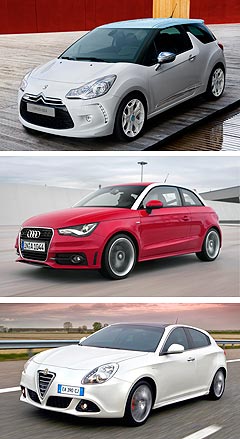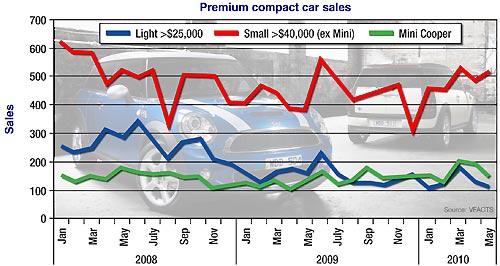News - General News - SalesPremium light switch turned onMajor Mini: Prestige small cars are coming thick and fast, following in the glowing wheels tracks of the Mini. Sales trends should shift as prestige brands continue to turn to compact cars14 Jun 2010 By TERRY MARTIN WITH the global shift toward smaller, more fuel efficient cars, and the growing influence of developing countries such as China, the world’s prestige auto manufacturers are working hard to remain – or, indeed, become – relevant at the lightweight and, gulp, lower-margin end of the market. Not so long back, few would have imagined that Aston Martin would dare build a baby hatch, that Ford would trot out a micro-car for Lincoln, that BMW would produce a front-drive model series with half an inline-six engine and that the retro Mini Cooper would become the benchmark premium compact from which the likes of Audi, Mercedes, Alfa Romeo, Citroen and even BMW – which owns Mini – are now hell-bent on stealing share. Small and light-sized hatchbacks from prestige brands remain a niche in Australia, and while the margins are smaller for the car companies concerned, these models are still adding to the bottom line, fuelling sales growth, reducing brand-wide carbon emissions and winning new customers who might well develop a lifelong association with the marque. That old chestnut about smaller cars damaging a premium brand’s reputation, as Mercedes endured with its pioneering A-class, seems to be no longer valid for most prestige manufacturers – and certainly no reason to hold back on new model development.  From top: Citroen DS3, Audi A1, Alfa Romeo Giulietta. From top: Citroen DS3, Audi A1, Alfa Romeo Giulietta.While Mercedes is now reshaping the A- and B-class, having watched BMW succeed with its sportier 1 Series, the seismic shift towards low-carbon, high-economy cars has encouraged the world’s premium car-makers to take a lead role in developing smaller model families with advanced construction techniques and materials and hi-tech conventional and alternative powertrains. BMW, for one, is building a green Megacity family while Mercedes-Benz is well advanced in developing new takes on its compact series, both with an improved sandwich-floor platform (for electric-drive models) and with an all-new architecture for compact models that use optimised conventional internal combustion engines. Closer than those, Audi has the all-new A1 compact coming soon. Citroen has the DS3. Aston Martin is preparing to launch its Toyota iQ-based micro, the Cygnet. Alfa Romeo has the bigger Giulietta, which will replace the 147 and tackle the 1 Series, B-class, Audi’s strong-selling A3 and the recently overhauled Volvo C30. Many of these new models, and others, will have a profound influence on sales charts across the globe, and in the Australian microcosm, will produce some sharp turns in the graph accompanying this report which tracks the sales performance of prestige light and small cars – and the Mini Cooper S in particular – over the past two-and-a-half years. As we might have expected, the light (above $25,000) and small (above $40,000) segments have struggled in accordance with deteriorating economic conditions, although the light segment has not done as well in climbing back out from the downturn. Given that the Mini Cooper hatchback is categorised as a $40,000-plus small car (when it is a light car that starts from just over $30,000), we have leeched its sales out from the prestige small-car segment and stood it alone to show that while it, too, is far from immune from the ebbs and flows of an uncertain economic environment, it often still manages to outsell all other compacts on the market combined – including the MiTo, Citroen C3, Fiat 500, Peugeot 207 and Renault Clio. The Mini hatch is averaging around 170 sales a month in 2010 year to date, and has returned a solid 140-150 sales a month (on average) since 2007. Those sorts of numbers are what Audi Australia will be aiming for with the VW Polo-based A1, if it can get its hands on enough cars. In Europe, Audi has already registered more orders for the A1 than for any other model it has ever launched, exceeding the production target of 50,000 units planned for this year. The aim is to build around 80,000 A1s in 2011, with annual production eventually ramping up to more than 100,000 a year. By way of comparison, BMW has just announced that it sold about 19,000 Minis (including cabriolets) last month, which was up 2.7 per cent. Last year, it sold 216,500 Minis, down from 232,000 in 2008. You will have heard explanations of the success behind Mini: full of character, fun to drive, fully customisable. Its high profile, pleasing design and successful retro positioning have also combined to make it a consistently strong performer on the sales charts when others, priced too high and without the same sort of attributes, have been left behind. Built along the same lines as BMW’s Mini, the A1 should also succeed in not just providing existing owners with a second car for spouses or kids, but in achieving most of its sales with first-time customers. Indeed, Audi predicts that, at a global level, up to 90 per cent of buyers will be new to the brand. We have not yet seen the baby Rolls, the Maybach micro. But as Range Rover foregoes four-wheel drive, as Maserati mulls a small sportscar and Ferrari feels good about the prospect of V6 power, wherever we turn we can see world-renowned premium brands changing like never before.  |
Click to shareGeneral News articlesResearch General News Motor industry news |














Facebook Twitter Instagram